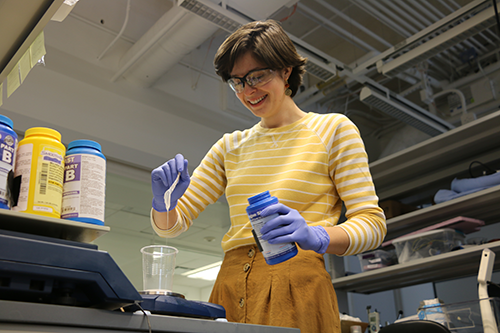Colostomates Project: Overview of the Need
The Colostomates project was started in 2018 by undergraduates in the Global Health Technologies minor. The project’s goal is to provide low-cost and long-lasting ostomy products to people in areas where cost and accessibility barriers prevent them from getting the supplies they need to care for their stoma.
As a result of these barriers, patients will often fashion their ostomy bags out of repurposed household items, such as plastic bread bags, tape, absorbent fabric, lids of jars, and belts. Unfortunately, these homemade solutions can lead to a higher risk of infections and can emit a strong embarrassing odor. Effectively, this life-saving surgery leads to social isolation from the embarrassment and social stigma of having an ostomy.
When I joined Rice360 as a fellow in 2021, I was very excited and honored to continue the work on this project. I had just finished my master’s degree in design science and my bachelor’s in mechanical engineering from the University of Michigan. My first ever experience with global health and medical device design was my senior design project in my last semester of undergrad.

Milestone Accomplishment: Testing with Ostomates
At the start of my fellowship, I focused on validating prototypes with non-ostomates through wear studies. Their feedback and validation helped make sure the design was functional and safe enough to send to ostomates. From these non-ostomate studies, I narrowed down what were the most comfortable and flexible materials, incorporated sizing changes to accommodate more body types, and pinpointed remaining design challenges to address moving forward.
Recently, I accomplished the huge milestone of conducting the first clinical study with ostomates! Through this first ostomate study, I have learned so much about the amount of preparation needed to run a successful clinical study. There is a large responsibility to make sure the study is conducted ethically, and there are many checkpoints that I would not have thought through if I had not written the protocol from scratch.
The feedback we received from ostomate participants was eye-opening. We learned how many of their needs we had previously made assumptions about and how much of our design and project approach needed to change to fully address the root needs. Moving forward, I’m going to work on using resources at Rice University by talking to materials experts to brainstorm solutions for our design challenges and leveraging the diversity and depth of experience on the Rice360 engineering team.
Fellowship Opportunities Outside of the Colostomates Project
Not only has the Rice360 Fellowship given me incredible experience working in global health engineering, but it has also allowed me to explore and grow in other areas. I have had the amazing opportunity to work with GLHT minor students to share my experience and answer questions about being an early-career professional in global health. I am forever grateful for the mentorship I received in college from alumni, recent graduates, and grad students, and I am so thankful that I can do the same for current students as a Rice360 fellow.

Fellowship Project Goals
My goals for the Colostomates project for the remainder of my fellowship include refining the bag design based on the ostomate feedback, doing another round of ostomates testing in the U.S. with an updated design, and starting to prepare for an international study. I’d like to complete a thorough needs assessment to reassess our current information as it aligns with the needs of people facing the cost and access barriers to proper stoma care. I’d also like to get feedback from clinicians and patients in our target areas on their initial perceptions of our prototype. From there, I can prepare the design for international clinical trials and bring it closer to public availability.
